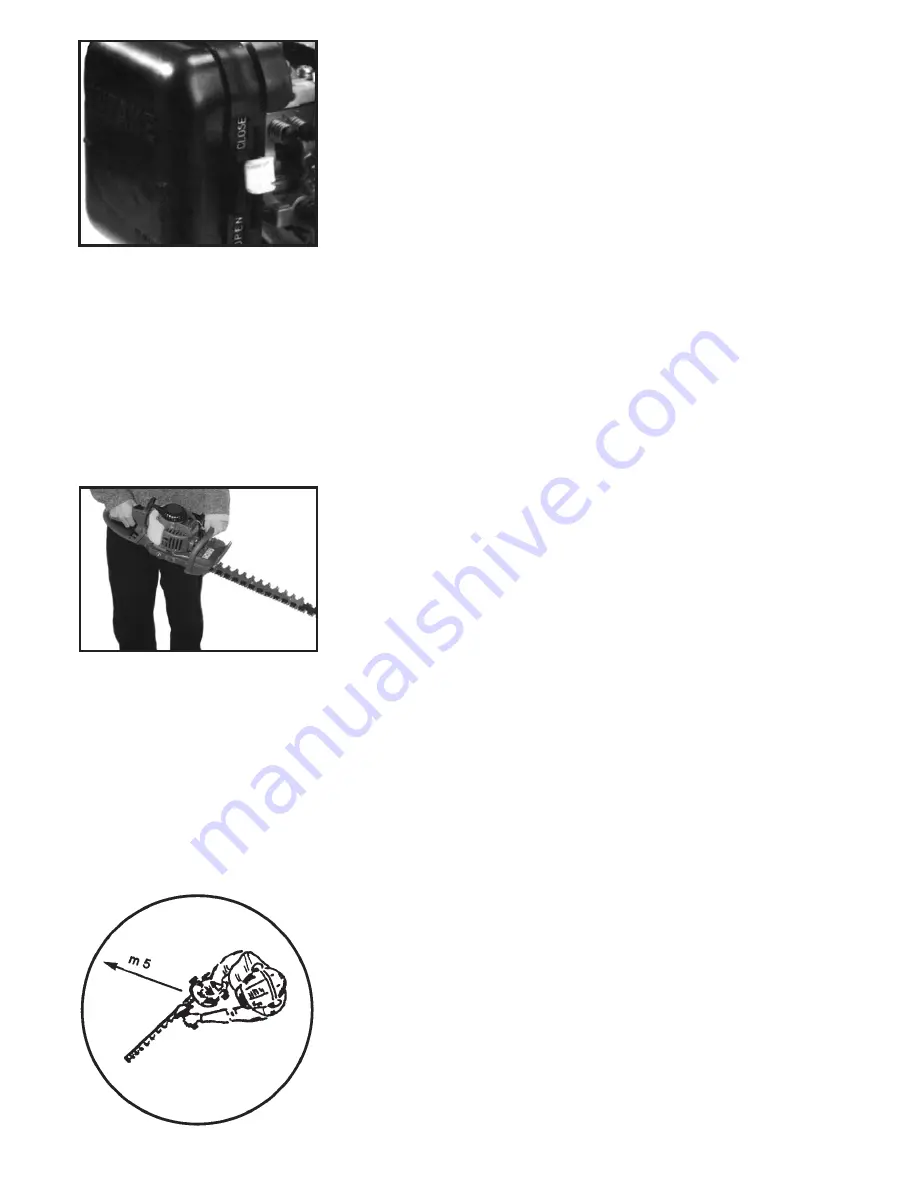
- 8 -
- 9 -
chamber.
IMPORTANT: when the engine is hot it is
not necessary to carry out the above said
operations. Simply pull the starting cord
till starting.
CUTTING DANGERS
When operating, firmly seize the
hedgetrimmer by both hands, never by one
sole hand, keep one hand on the throttle
lever which drives the work controls and
the other hand on the front handle. Never
remove hands from lever and handle as
long as blades keep moving (Fig. 15).
CORRECT USE
The hedgetrimmer is only used to cut
grass, shrubs and bushes with diameter of
branches not over 10 mm.
Pay attention to the use of this machine;
when it is running and proper cautions
such as explained in this manual have
not been taken, serious injuries may be
subsequent to.
Always follow the controls sequence such
as indicated. Caution is highly required
during operation!
a) Start the engine such as previously
explained.
b) When the engine is on, let it run at the
minimum speed for 2-3 minutes.
c) Accelerate a few times idling but never
to the maximum in order to check if
everything works properly.
d) With cutting blade in stop position, well
visible and always under your control, go
to your work place keeping it under the line
of your waist and far from your body and
make sure there are no persons in a range
of 5 meters (Fig. 16).
Now you can start working: place yourself
in a stable and safe position on your feet.
The mowing of the grass
has to be carried
out slowly and you must move laterally
step by step, making hedgetrimmer
oscillate from right to left. In the double-
side blade version, with alternate motion
left-right, right-left. If you unintentionally
hit some obstacles of big dimensions or
if the cutting blade gets caught, block
instantly for overload. If grass, vegetable
filaments, barks roll up around it, reduce
the speed to the minimum to disconnect
the clutch. Make sure that the blade, which
proceeds through inertia, has completely
stopped.. Now PUT OFF THE ENGINE. Put
the hedgetrimmer on the ground. Check if
the cutting blade has some damages like
cracks or teeth breaks etc. In this case
replace it. If on the contrary the tool is
covered with rolled up material, remove
it completely with your hands protected
by working gloves and with the help of
some tool.
All safety devices of the machine and also
the protection equipment must be kept
2) ponete la leva sulla cuffia aria (Fig. 14)
in posizione CLOSE, tirate la funicella
avviamento da 1 a 2 volte massimo.
Anche se non si dovessero sentire gli
scoppiettii, riportate la leva sulla cuffia
in posizione OPEN
3) tirate nuovamente la funicella avvia-
mento fino all’accensione del motore.
Se il motore non parte dopo il quarto
strappo ripetere le operazioni come da
punto 1.
Se, malgrado i ripetuti tentativi di avvia-
mento il motore non parte significa che
la camera di combustione è ingolfata. In
questo caso svitate e asciugate la can-
dela di accensione e tirate la funicella di
avviamento alcune volte senza candela
in modo da pulire-ventilare la camera di
combustione.
IMPORTANTE
: a motore caldo non occor-
re fare le operazioni di cui sopra, ma tirate
semplicemente la funicella avviamento
fino alla sua partenza.
PERICOLI NEL TAGLIO
Quando utilizzate il tagliasiepi, impugna-
telo sempre saldamente con entrambe le
mani. Mai utilizzare il tagliasiepi con una
mano sola!
Tenete una mano sulla manopola comando
gas che aziona i comandi di lavoro e l’altra
sull’impugnatura anteriore frontale (Fig.
15).
N.B. mai togliere le mani da manopola e
impugnatura finchè le lame sono in movi-
mento.
CORRETTO UTILIZZO
Il tagliasiepi serve esclusivamente per
tagliare cespugli e siepi con diametro dei
rami non superiore a 10 mm.
Fate attenzione nell’utilizzare questo
attrezzo: quando è in moto, e non avete
le opportune avvertenze come spiegato in
questo manuale, può arrecarvi delle ferite
anche gravi.
Seguite sempre la sequenza dei comandi
come indicato. Agite sempre con molta
prudenza!
a) avviate il motore come precedentemen-
te spiegato.
b) A motore avviato, lasciatelo funzionare
per 2-3 minuti al minimo dei giri.
c) Accelerate alcune volte a vuoto, ma mai
al massimo , per verificare che tutto
funzioni regolarmente.
d) A lame ferme, ben visibili e sempre
sotto il vostro controllo, raggiungete il
posto di lavoro, tenendole sotto il livello
della vita, rivolte verso il basso, lontane
dal vostro corpo ed assicuratevi che
non ci siano persone nel raggio di 5
metri (Fig. 16).
Ora siete pronti per iniziare il lavoro:
ponetevi in una posizione di equilibrio ben
stabili e sicuri sui piedi.
Fig. 14
Fig. 15
Fig. 16
















